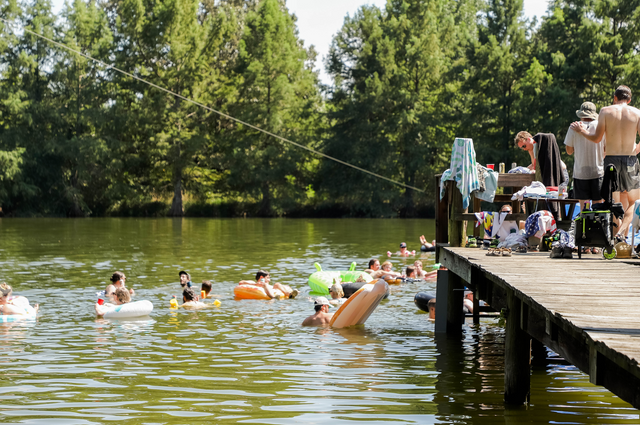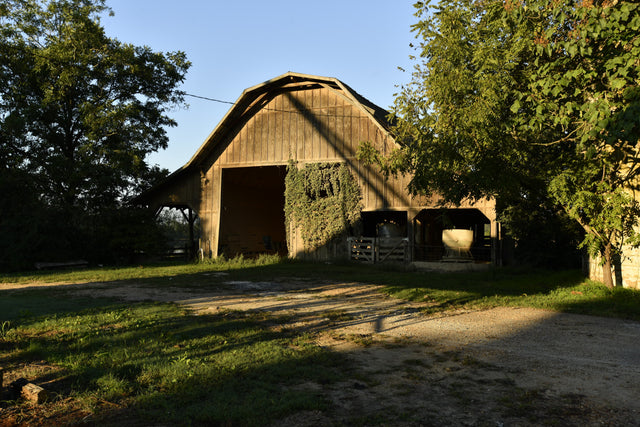
This week we would like to discuss the beef supply chain. Please bear with us- this might get a little wonky. Disclaimer: I am making very general claims and descriptions for explanation purposes; variations from these descriptions certainly exist.
As some of you may know, from the time a calf is born to when it is ready to slaughter takes 2 years to *30 months. This 24 to 30 month journey is segmented into specialized producer groups. The most common of these in the southeast is the cow-calf operation. As you cruise country highways enjoying pastoral scenery, this is what you see (with the exception of a rare dairy operation). A farmer will maintain a herd of mamma cows and a bull or two, and sell their annual calf crop after weaning. Usually the calves are sold through a local auction or through a contracted buyer, or through larger regional auctions like West Plains, Missouri. From here the calves (around 550 lbs at this point) are usually purchased by a backgrounding operation, which supplement feeds but mostly grazes the cattle up to around 800 to 1000 lbs. From here they are sold to a feedlot (or contract finished), where they are concentrated and finished on a energy rich, grain based diet, up to 1200 to 1400 lbs. There are many variations of this supply chain, but this is the basic flow. Finishing operations and kill plants are in the midwest. Almost all of the calves produced from the cow-calf operations here in the southeast end up in these finishing programs via contract buyers or small local livestock auctions.
As some of you may know, from the time a calf is born to when it is ready to slaughter takes 2 years to *30 months. This 24 to 30 month journey is segmented into specialized producer groups. The most common of these in the southeast is the cow-calf operation. As you cruise country highways enjoying pastoral scenery, this is what you see (with the exception of a rare dairy operation). A farmer will maintain a herd of mamma cows and a bull or two, and sell their annual calf crop after weaning. Usually the calves are sold through a local auction or through a contracted buyer, or through larger regional auctions like West Plains, Missouri. From here the calves (around 550 lbs at this point) are usually purchased by a backgrounding operation, which supplement feeds but mostly grazes the cattle up to around 800 to 1000 lbs. From here they are sold to a feedlot (or contract finished), where they are concentrated and finished on a energy rich, grain based diet, up to 1200 to 1400 lbs. There are many variations of this supply chain, but this is the basic flow. Finishing operations and kill plants are in the midwest. Almost all of the calves produced from the cow-calf operations here in the southeast end up in these finishing programs via contract buyers or small local livestock auctions.

Home Place Pastures, and other vertically integrated, grass fed operations, have to reinvent this complex system on a much smaller, regional scale. It’s not easy. For example, it is not feasible from a cost, land availability, and management perspective to only sell beef that was born, weaned, backgrounded, and finished here on the farm.
A preferable model for us is to purchase backgrounded cattle at 800 lbs, and finish them here on grass. To achieve this, we need a network of producers who adhere to our environmental and animal husbandry practices (no grain, no antibiotics), and we have to get them approved by our grass fed verifying agency (in our case the Agricultural Marketing Service through the USDA). We also need producers who are willing to background their calves on grass after weaning from 600 to 800 lbs. Most cow calf producers do not have any extra pasture, infrastructure, or interest to do this. Also a major factor, the market has not created much of an incentive to do this. On top of all this, we need producers who have the right genetics for creating calves that will gain weight on a forage based diet (much different than genetics for marbling on grain diets).

In an ideal world (which obviously doesn’t exist), we would maintain and gradually grow our cow calf herd (roughly 20 cows currently), and rely mostly on producers to supply us with hundreds of 800 lb stockers ("8 weights" in industry jargon), which we will finish on forages on the Home Place.
Think about this: To maintain a mama cow herd, background, and finish 100 percent of our beef at our current beef sales numbers, we would need a mama cow herd of roughly 800 head, requiring roughly 2400 acres of pasture. Then, we would need an additional 1800 acres to background steers and replacement heifers, and an additional 800 to 1000 acres for finishing. So with excellent management, we would require north of 5000 acres, and at peak volumes we would carry around 2700 cattle. This is obviously not in our realm of possibilities, at least not here at the Home Place. I hope this clarifies the need to pull from a producer network and break down this supply chain into a more manageable and specialized program.
The huge advantages here are
- This provides a scalable production system with minimal infrastructure, which we can use to finish 100 percent of our beef here on the Home Place.
- Adding value to regional cow calf producers by bringing them into our premium program.
- Through an intensive finishing program (vs cow calf), it is more financially feasible to transition the entire Home Place into a carbon sequestering, soil building, regenerative agricultural model (including all the row crop acreage).
- We have the acreage to finish our current supply here on the Home Place, which helps us with our label claims, supply chain, and bottom line, as opposed to sourcing grass finished cattle from other farms.
- Our money is tied up in the stockers for only 6 months (as opposed to over 24 to 30 months with our own calves)
- We can control peak stocking densities to align with peak forage production.
- Better control of the quality and consistency.
Advantages to maintaining our own smaller cow calf herd on additional rented pasture are:
- Some control of the supply chain by feeding our own calves into our finishing program.
- Selling seed stock (bulls) and heifers with excellent genetics to our cow calf producers.
The cons to sourcing and finishing 800lb stockers:
- Difficult to find producers who will take calves from 600 to 800 lbs- those who do are often already contracted into a premium niche market.
- Susceptible to commodity market fluctuations in feeder cattle market.
- Biosecurity concerns from bringing cattle in from different farms and mixing them- can spread pesky issues like pink eye or more serious diseases. We do not use antibiotics- so this can present some serious management challenges.
The long term vision, and the reason I’m laying this out in boring detail, is to transform a small amount of this region’s beef supply chain. Instead of shipping all our calves out of the southeast at commodity prices, to be packed in with thousands of other calves, pumped full of antibiotics, stuffed with grain, and causing all kinds of health and environmental problems along the way, maybe we can keep more of our beef right here, from start to finish. Not on one farm, but on a network of family farms throughout the southeast region. This would have numerous direct and indirect benefits for our region, including:
- Less shipping, and therefore less carbon emissions and stress on cattle
- More money for cow calf producers
- New market and land utilization opportunities for backgrounding cattle
- More acreage put into regenerative agricultural production models, with emphasis on soils, biodiversity, and forages.
- Healthier water sheds
- Recent studies suggest that intensively grazing forages year round actually sequesters more carbon than the cattle emit, making grass finished beef a carbon sink.
- Less antibiotic use, and therefore less microbial resistant bacteria, a growing human health concern
- A more resilient food system that is not as vulnerable to national or international supply chain issues (think massive beef/ pork recalls and the COVID 19 related meat shortages).
- Better jobs and healthier meat.
- Keep dollars in regional rural communities, instead of having them vacuumed up by multinational conglomerates.
We can, over time, build a more sustainable and profitable supply chain here in the Southeast. Grass fed and finished beef is key to making this work. To flesh out our decentralized, small scale, regional agricultural model, we will have to spend years consulting with cow calf producers, improving genetics, building soils, growing consumer demand, and, perhaps most importantly, building a profitable financial model that will sustain and justify the whole production system. This financial model will necessarily include financial incentives for each part of the supply chain (cow calf, backgrounders, finishers), to entice producers to change from existing market channels and deal with our standards and audits. It is important to note that Home Place Pastures is not alone in contributing to this model- other vertically integrated regional producers are already innovating and succeeding in this space.
As with most business models, the key here is scale. However, unlike other business models there is an endpoint to that scale. Remember the quote I borrowed from Lorentz Meats and Vermont Packing House: “big enough to matter, small enough to care.” The key for you, the consumer, is transparency along the way. In return, farmers need your support if we are to truly transform the current meat industry into a more regional, environmental, and animal based system. The demand for cheap prices created the current system; the demand for better food is creating a new one. Keep investing a little more in your regional food producers when you can, and we will keep chipping away at the challenges.
Together, farmers, meat packers, and consumers can divert a tiny stream from the river of calves and dollars flowing from the southeast to centralized multinational conglomerates, and pour it into regional businesses who are invested in our communities, our animals, our land, and our economic well being.
Think all this over, and let us know what you think! If you come across some (preferably fenced) pasture, and want to dive into a new business venture, I recommend backgrounding calves for Home Place Pastures!
Marshall
Think all this over, and let us know what you think! If you come across some (preferably fenced) pasture, and want to dive into a new business venture, I recommend backgrounding calves for Home Place Pastures!
Marshall
More stories

The Hill Country Boucherie Guide to Supporting Small Businesses
Alison Schreuder
·

HR should stand for hard & robust, am I right?
Home Place Pastures
·

